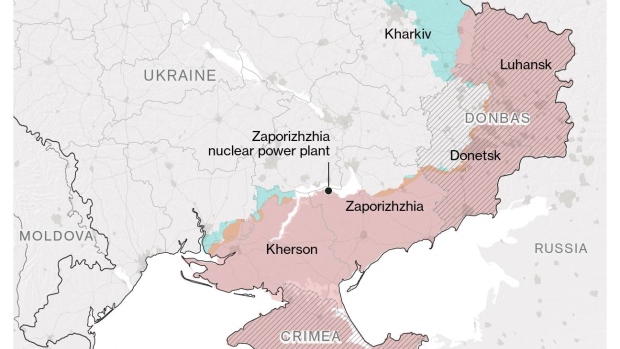Sep 21, 2022
Putin Announces ‘Partial Mobilization,’ Stepping Up Ukraine War
, Bloomberg News

(Bloomberg) -- Russian President Vladimir Putin declared a “partial mobilization,” calling up 300,000 reservists, in a major escalation of his flagging invasion of Ukraine, which he portrayed as a fight to the death with the US and its allies.
As Russia moves to annex occupied Ukrainian territory, Putin also renewed his warnings of a nuclear threat. “When the territorial integrity of our country is threatened, we will certainly use all the means at our disposal to protect Russia and our people,” he said in a televised national address Wednesday. “This is not a bluff.”
“Those who are trying to blackmail us with nuclear weapons should know that the wind patterns can also turn in their direction,” the president said, accusing the US and its allies of seeking to “destroy” Russia.
Putin’s latest threats come after a Ukrainian counteroffensive in the last few weeks dealt his troops their worst defeats since the early months of the conflict, retaking more than 10% of the territory that Russia held.
WWII Precedent
The mobilization - the country’s first since the Nazi invasion in World War II, according to historians - isn’t likely to be enough to slow Ukraine’s advances on the battlefield soon. Kyiv now has more troops armed with advanced weapons supplied by the US and its allies.
German Chancellor Olaf Scholz called the mobilization “an act of desperation.” He told reporters in New York, “Russia can’t win this criminal war. Putin is now banking on further military escalation and is only making things worse.”
Russia Sees Smaller Economic Hit From Sanctions as War Escalates
The U.S. saw no immediate need to react to his latest nuclear threat. “We’re monitoring as best we can their strategic posture so that, if we have to, we can alter ours,” US National Security Council Spokesman John Kirby told ABC’s “Good Morning America” on Wednesday. “We’ve seen no indication that that’s required right now.”
Throughout the conflict, Putin has sought to raise pressure on the West - cutting energy supplies, hinting he may use nuclear weapons - in attempts to undermine support for Kyiv. So far, those efforts have largely had the opposite effect.
World financial markets largely brushed off the news, with investors focused mainly on the US Federal Reserve’s interest-rate decision later Wednesday. Treasuries and the US dollar gained as investors sought havens after Putin’s remarks, while oil prices rose and Russian stocks plunged.
The mobilization order and nuclear threats “represent a major escalation but in the short-term it’s unlikely this is going to change the dynamics on the front line,” said Oksana Antonenko, a director at Control Risks in London. “Russia will continue to suffer from the same problems and the Ukrainians will try to take advantage of this to continue to push forward and recapture territory.”
Russian Defense Minister Sergei Shoigu told state TV the reservists wouldn’t be called up all at once. The order applies only to those with military experience and wouldn’t affect students or others who haven’t previously served in the army, he said.
The additional troops would be more than the approximately 180,000 that the US estimated Russia had massed at Ukraine’s borders before the Feb. 24 invasion. Ukraine, which declared a mobilization early in the war, now has around 700,000 in the field with months of training and has said it aims to create a million-strong army.
Putin made his threats a day after Russian-installed occupation authorities in the regions of Ukraine’s east and south that Kremlin forces still control hastily announced plans for “referendums” starting Friday on annexation. This would incorporate the roughly fifth of Ukrainian territory Russia controls behind its borders.
Ukraine and its allies denounced the planned votes as shams and vowed to continue fighting to retake the lands, which cover parts of the Donetsk, Luhansk, Kherson and Zaporizhzhia regions.
Once the annexation takes place, Russia will also be able to bolster its forces fighting in Ukraine with conscripts doing their military service, who currently can’t be sent to the front line because it is outside Russian territory, said Igor Korotchenko, head of the Moscow-based Center for Analysis of World Arms Trade.
Still, increasing the size of Russia’s military involved in the campaign isn’t enough by itself to reverse the momentum, said Korotchenko. “The issue isn’t the quantity (of soldiers) but the capacity to supply them with weapons and gear.”
Why Ukraine’s Donbas Region Matters to Putin: QuickTake
The widespread call-up risks inflaming public discontent. One opposition group called for national protests Wednesday, triggering warnings of a harsh response from police. Soccer club fan forums were flooded with worried posts, while Google data showed a spike in search queries on how to leave Russia with flights to Turkey and Armenia almost immediately sold out. Under a mass mobilization any potential draftee is barred from leaving their place of residence and it was not yet clear if the same restrictions will apply.
Most of the Russian public has been largely insulated from the realities of the invasion since it began and the Kremlin had for months sought to minimize the impact. Even a partial mobilization threatens to change that.
Parliament Wednesday gave final approval to hastily proposed legal changes that would stiffen criminal penalties for dodging the call-up, as well as for desertion and surrender. Russian forces have suffered from low morale that has worsened since the recent reverses.
©2022 Bloomberg L.P.






